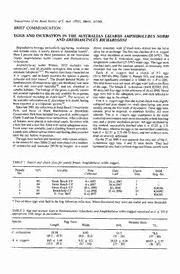
Eggs and incubation in the Australian lizards Amphibolurus nobbi and Eremiascincus richardsoni PDF
Preview Eggs and incubation in the Australian lizards Amphibolurus nobbi and Eremiascincus richardsoni
, Transactions ty* lite Ami SotMycfS. Auxt. (1992), il$|4)t 147-!4& BRIEF COMMUNICATION EGGS AND INCUBATION IN THE AUSTRALIAN LIZARDS AMPHtBOLVRUS NOBBI AND EREMIASCINCLS RICHARDSON! Reproducing biology, particularly egg-laying, incubariou plastic container, with 12 small holes drilled into me hd to and neonate sizes, is poorly known in Australian lizard*1. allow forairexchange. Thefirst twoclutchesofA. n. coggen Here I present data on these parameters in the Australian eggs were incubated at room temperature (20-34°C), the ll^a^d^ Arnphihotnras nobbi coggeri and Eremiascincus others, and the E. tichardsoni eggs, were incubated tn a richardsoni. temperaturecontrolled(27-3l°C)snakecage. Theeggs were Amphihoturus nubbt Wiuen. 1972 includes two checkeddaily, and the medium sprayed, as necessary, with 2 subspecies , and all available ecological data relate to the rainwater (hat was the same temperature. nominatesubspecies'*'4^. No studieshave beenconductedon Each A. n. coggeri laid a clutch of 5-7 eggs A- n. coggeri, and in South Australia the species is poorly (24 x) 1Q87-10.I I99i) (Table 1). Female SVL and clutch size collected and little known6. The Desert Banded Skmlcs or werenotsignificantlycorrelated(r = 0-8465.0.1 > P > 005). Sandswimmerv(Eremiascincusspp.)aredistributedovermost Thenestboxes werenot used, alleggswerelaidonthefloor of arid and semi-arid Australia78, and are abundant in of(he cage. The female E. tichardsoni (NAM R37015, SVL suitablehabitats. Thebiologyofthegenus is poorly known 90 mm) laid foui eggsintheafternoonof 18.xii.l990. These andaccuratereproductivedataareonlyavailableloroviparous eggs were laid in the sphagnum moss, and each adhered to £. richordsoni recording its clutch size1**. The accuracy of oneother egg in the clutch. theavailableinformationonE.fasxiolarusisindoubr.having l-iveA. n. coggerieggsfromdiesecondclutchwereslightly been reported as a viviparous species1-*. collapsed and pear shaped (vs. oval) upon laying, and went Sincelate 1987, mycollectionsatSwanReachConservation mouldy duringthe firstweek ofincubation. Theseeggswere Park, and those of Mark Hutchinson in Brooklleld opened, prior to disposal, to establish fertility. AJ] were Conservation ParkhaveincludedfourgravidA. nobbicoggeri infertile. The A, n. coggeri eggs maintained in the more (Table I)andoneEremiascincusrtcJuirdsoni Aftercollection controlledenvironmentweremoresuccessfulinbothhatching all females were placed in individual cages, hjrnished with rate, andashorter incubationperiod. All eggs incubated by ahideboxanda nestboxfilledwith moistsphagnum mosx. this method, successfully hatched after x - 47.25 + 2.71 Fte-sh waterwasavailable,and aclimbing branch provided. (44-50)days, whereastheeggsintheuncontrolledconditions Lizardswereofferedvariousinsectsandfeedingoftenoccurred tookx = 62.57 ± 2.71 (56-73days), andtwoembryoswere until the day before oviposilion. dead orseverely deformed. toTthheeneegagrseswte0r.e1mmamrk(eTdabalned2m)eaansdurweedr,ewpiltahcveedronineracmaelidpierusm, ricOhnartdhseon2i7.xeigig.s19(9n0osit.wa2smaipdpar3e)ntwethraetofnerltyilet.woThofeytheha£,d ofvermiculite and rainwater (50:50by weight), in a small increasedinsize, hadapinkishtingeandblood vesselswere TABLE 1 Sourrc andclutch sizesforgravidfemale Amphibolous nobbi coggeri Female SVL Locality Date Date Cluwh SAM No Collected Laid Size Reg, No. 1 80 Swan Reach CP 9.x.1987 24.XLI9R7 7 2 84 Swan Reach CP 9.x.1987 28.xi.l987 7 3 74 Swan Reach CP 18.xi,1989 10.1.1990 5 R36316 4 80 Brookfield CP l.xii.1990 12.xii 1990 5* R36997 5 69 Ti Tree Well 8xii.l977 4 R165B7 Twooftheseeggs were laid in the bag following collection. Whendiscovered they were notviable and werediscarded. TABLfc Z Eggandneonatesizes in Eremiascincus.richardsom andAmphibolums nobbi coggeri expressedaxx ± SOif appropriate \n'th range in parenthesis. Species Egg .Sizes Neonate Sizes Length Width SVL TL f richardsoni 1S58 9.95 J8.5 (16.5 - 19.5) (9.9 10.1) (31 - 34} <77-80) 4 h txf^ert 16,0 ± 1,49 9.12 ± 03 28.53 -* 0.74 R0.67 ± 297 (12 I • 18.3) (8.7 - 9.6t <27 - 30) (76 • 87) 148 lorming (inthe inside wall*. Eggs 1 and4 had not changed (16.8 x 8.2 mm) suggests that these eggs were near in size or colour, and were thought to be infertile. ovipoMtion. The only data for clutch sizes in A. nobbi are Measurements ofthe eggs could not be taken at this stage related lo the nominate subspecies (3-4> , which has a due to the adherence and shape ofthe mass. Alter 36 days smallerclutchsizethanreportedhereforA. n. coggeri(4-7T winacsubnaottiiocne,doant231.93i519h9r1,tbhuetshtehlelloinzaergdgdindo.n2olhaedmesprlgite.Tunhtiisl Ta\hri£s. assugAg.esnt.scaogcgorrrrieliastiloanrgebrettwheaennthfeemnaolmeinsaitzee aranedcc\luTthceh 0315 hr the nextmorning. The shell on egg no. 3 was spin clutchsizereportedheretorA- n. cof>geriis,however, similar at2020hron23.i 1991 and fullemergenceoccurredat0922 to those reported for A. muricafus and A norrisi (3 8 and hi thenextday. after 13hours intheopeneggshell. Theother .V7 respectively)1. A. nabbfs closest relatives'-11, and both tdiwsocaergdignsg,(Itoacnodnf4i)rwmetrheemmotoulbdeyinfaerntdilew.eTroeoofpeewneedggsbewteorree vthses1e00spaencdies11a0rcmrmepoSrVteLdlroesbpeecltairvgeelry)t7ha,nA. n. coggeri(75 availabletopermitopeninganeggtodetermineatwhatstagc- Nofartherspecimensofgravid% richardsoniwerefound, oitn'ceumbabtriyoonnpiecridoedveslhoopwmnenhtertehiiss ssipmeicliaerstolatyhsatitfsoregOgsc.noTwhse hwuetllt-wdoevEe.lfoapseddoohvtiudusc(alR3e0g9g4s8(a5nadnRd3361r3e7s)pewcetirveelfyo)u.ndThweisieh taenioiatu*. a similar sizedskink, whoseeggr,werelaidat eggs were surrounded by a thin shell membrane, the stage 30Kl. All neonatesweremeasuredathatching(Table2). appearanceofwhich suggeststhattheeggswouldhavebeen col.lMeocsttioonfstihteeAo-fitt.heciorggreersipencieiovneatepasrewnetrse. rTehleeasdeedfoatrmtehde voiTdheed.egg-laying reported here confirms observations on specimen and four neonates were placed in the South oviparity inE. nchxrdsoni^\ and(he findingsfromdissected Australian Museum (SAM R35S43-44,3631849and37951). Museum specimens supports the suggestion mat previous ThTeoEs.uprpilcehamnelnxtrmtihenoebosneartveastiwoenrserempaoirntteadinheedr.e, specimens repTohretsSo.fA.vivNiaptairiotnyalinPaE.rksfas&civWlialtdulsifmeaySebrevicineeprrroorv.ided held in the South Australian Museum were examined for collectingpermits- DrMark.Hutchinsoncollectedtwoofthe gravid females. Orccr examined all specimens of specimensonwhichtheseobservationswere made,allowed tfhierreemfioarsecionncluyssipneSctiamleenMsuosfeEurmemcioalslceictnicounssrpergiiosrtelroed19a7ft9e\r mmaenutsocreixpatm.inAedrMieunsneeuEmdwsapredcsimpernosviadneddrdeaatdadfroarftMsuosfetuhme that year were examined. specimens and Brian Miller assisted with weighing the oviOdnulcyaloengegssp(Teacbilmeen1).ofThAe, lrair.gecstogegegrgim(Rthi1s6s58p7e)cihmaedn ndreaofntasteosf.thDeamvaindusLcarinpgtd,ownhaincdhwEadsMtcyApleidsbtyerJurdeyadWotohelmfainnal 'Greer, A. E. (19901 "Biology and EvolutionofAustralian Australian Museum, Adelaide.) Lizards". (Surrey Beatty & Sons. Chipping Norton). 7Cnggtr,H.G.(1986)"ReptilesandAmphibiansofAustralia" 2?WWiUtttuein.,GG..&J.A(1S9t7u2d)yHoefrApmcpthoilboagliucarn2s8(n3o)b.biWWri^tStfcSn,. 1972. *4Gtrh«**Erd,.A(.ReEe.d,(1S9y7d9n)eyR)e.c. Aust. Mus. 32(7), 321-338. 4UWintptuebnl,. GM..SJc..(1T9h7e4s)isAuUMn.ive2rpspilt.y o18f(2N).Vw12E9n-1g3l2a.nd. 1"0iDfiei'fIaoru,re.T1.J.A.P.(&19H8u5)beHretr,pcJ.to(l1o96g1i)caAr4c1h(.4)A,na4t0.8-M4i1c8roscup. sW3i6t2-t3e6n4,.G. J. & Heatwole, H. (1978) Copeia 1978(2), 11WMiotrtpchno,l.G.EJx.p-&5C0o.ve3n0t9r-y3,28A..J. (1984)Proc. R. Soc.Vicr. ^Houston, T. F. (1978) "Dragon Li/ards and Goannas ot 96(3). 155-59. South Australia". Special EducationaJ BulletinScries. (South T. k* MORLEY. Royal Zoological Society ofS.A., Frome Road, Adelaide, S. Aust. 5000.
